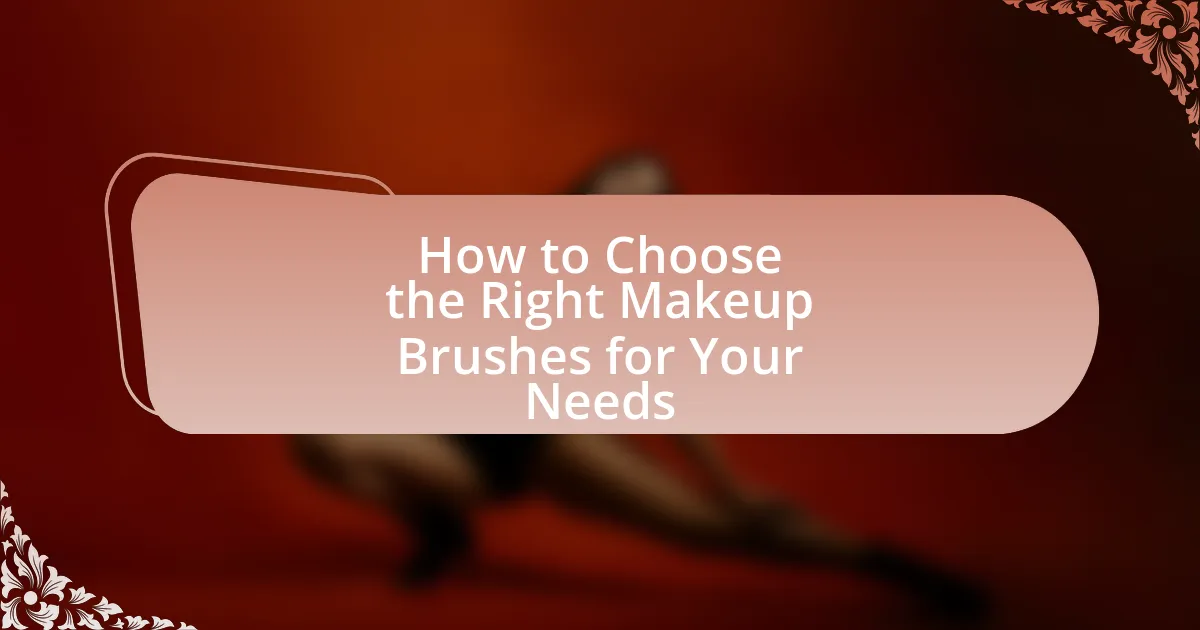The article focuses on how to choose the right makeup brushes tailored to individual needs. It covers essential factors such as brush material, bristle type, density, and shape, which influence makeup application and finish. Key sections include the benefits of synthetic versus natural bristles, the importance of brush size and shape for precision, and maintenance practices to extend brush longevity. Additionally, it provides guidance for beginners on essential brushes and tips for selecting quality tools based on specific makeup techniques and personal preferences.

What Factors Should You Consider When Choosing Makeup Brushes?
When choosing makeup brushes, consider the brush material, bristle type, and intended use. The brush material affects durability and application; synthetic brushes are often better for liquid products, while natural bristles excel with powders. The bristle type influences the finish; for example, dense bristles provide full coverage, while softer bristles offer a more diffused look. Additionally, the intended use, such as foundation, eyeshadow, or contouring, dictates the brush shape and size needed for optimal application. These factors ensure that the brushes meet specific makeup needs effectively.
How do different brush materials affect performance?
Different brush materials significantly affect performance by influencing the application, blending, and finish of makeup products. Natural hair brushes, made from animal fibers, typically offer superior softness and blendability, making them ideal for powder products. In contrast, synthetic brushes, crafted from nylon or polyester, excel in applying cream and liquid products due to their ability to hold and distribute product evenly. Research indicates that synthetic brushes are more hygienic and less prone to harboring bacteria, which can enhance skin health during makeup application. Therefore, the choice of brush material directly impacts the effectiveness and outcome of makeup application.
What are the benefits of synthetic vs. natural bristles?
Synthetic bristles offer benefits such as being more hygienic, cruelty-free, and versatile for various makeup products, while natural bristles excel in blending and providing a softer finish. Synthetic bristles are made from materials like nylon or polyester, which do not absorb product, making them ideal for liquid and cream formulations. In contrast, natural bristles, derived from animal hair, are better suited for powder products due to their ability to pick up and distribute powder evenly. Studies indicate that synthetic brushes can be easier to clean and maintain, reducing the risk of bacteria buildup, while natural brushes can provide a more seamless application due to their unique texture.
How does the density of bristles influence application?
The density of bristles significantly influences the application of makeup by affecting the amount of product picked up and distributed. Brushes with high bristle density tend to hold more product, allowing for fuller coverage and a more intense application, which is ideal for products like foundation or cream blush. Conversely, brushes with lower density provide a lighter application, making them suitable for blending or applying sheer products, such as powders or highlighters. This relationship between bristle density and application technique is supported by the fact that professional makeup artists often select brushes based on the desired finish, whether it be sheer, medium, or full coverage, demonstrating the practical implications of bristle density in makeup application.
What types of makeup brushes are essential for beginners?
Essential makeup brushes for beginners include a foundation brush, a concealer brush, a blush brush, an eyeshadow brush, and a blending brush. The foundation brush allows for even application of liquid or cream foundation, while the concealer brush helps to cover blemishes and dark circles effectively. A blush brush is designed to apply blush smoothly on the cheeks, and the eyeshadow brush is crucial for applying color to the eyelids. Lastly, a blending brush is essential for seamlessly blending eyeshadow for a polished look. These brushes form a basic toolkit that enables beginners to achieve a variety of makeup looks with ease.
Which brushes are necessary for a basic makeup kit?
A basic makeup kit requires five essential brushes: a foundation brush, a concealer brush, a powder brush, a blush brush, and an eyeshadow brush. The foundation brush is used for applying liquid or cream foundation evenly on the skin. The concealer brush helps in covering blemishes and imperfections with precision. The powder brush is essential for setting makeup with loose or pressed powder, ensuring a smooth finish. The blush brush is designed for applying blush to the cheeks, providing a natural flush. Lastly, the eyeshadow brush is crucial for applying and blending eyeshadow on the eyelids. These brushes collectively enable effective makeup application, making them fundamental for any makeup routine.
How can you identify quality brushes for beginners?
To identify quality brushes for beginners, look for brushes made with synthetic or natural bristles that are soft, durable, and well-formed. Quality brushes typically have a sturdy handle that provides a comfortable grip and allows for precise application. Additionally, check for brushes that have a good balance between bristle density and flexibility, as this ensures even product distribution. Reviews and recommendations from reputable beauty sources can also guide beginners in selecting brushes that have been tested for performance and longevity.
Why is brush shape important in makeup application?
Brush shape is important in makeup application because it directly influences the precision and effectiveness of product placement. Different brush shapes, such as flat, round, or angled, are designed for specific tasks; for example, flat brushes are ideal for applying foundation evenly, while tapered brushes excel at blending eyeshadow into the crease. The shape of the brush affects how the bristles distribute product, allowing for varied techniques and finishes. Research indicates that using the appropriate brush shape can enhance the overall makeup look by improving application control and achieving desired effects, such as sharp lines or soft blends.
What are the different shapes of brushes and their uses?
Different shapes of brushes include flat, round, angled, and tapered, each serving specific purposes in makeup application. Flat brushes are ideal for applying foundation or eyeshadow, providing even coverage. Round brushes are versatile, suitable for blending and applying products like blush or highlighter. Angled brushes are designed for precise application, particularly for contouring and defining the brows. Tapered brushes excel in detailed work, such as applying eyeshadow in the crease or highlighting specific areas of the face. These shapes enhance the effectiveness of makeup application by allowing for varied techniques and finishes.
How does brush shape affect the finish of makeup?
Brush shape significantly influences the finish of makeup by determining the application technique and product distribution. For instance, flat brushes are ideal for applying foundation evenly, while tapered brushes allow for precise contouring and blending. The density and shape of the bristles also affect how much product is picked up and deposited on the skin, impacting the overall finish. A study published in the Journal of Cosmetic Science highlights that different brush shapes can create varying levels of coverage and texture, confirming that the right brush shape is essential for achieving the desired makeup effect.

How Can You Determine the Right Size of Makeup Brushes?
To determine the right size of makeup brushes, assess the area of application and the desired finish. Larger brushes are suitable for broad areas like the face, while smaller brushes are ideal for detailed work, such as eyes or contouring. For example, a foundation brush typically has a larger head to cover more surface area quickly, while a precision brush for eyeliner has a fine tip for accuracy. The size of the brush should also correspond to the product being used; cream products may require denser brushes, while powders can be applied with fluffier brushes.
What sizes of brushes are available and what are their uses?
Brushes are available in various sizes, including small, medium, and large, each serving specific purposes in makeup application. Small brushes, such as detail or precision brushes, are ideal for intricate work like eyeliner or spot concealing. Medium brushes, often used for blending eyeshadows or applying foundation, provide versatility for various makeup techniques. Large brushes, such as powder or stippling brushes, are designed for applying products over larger areas, like setting powder or bronzer. The size and type of brush directly influence the application technique and finish, making it essential to choose the right size for the desired makeup effect.
How does brush size impact precision in application?
Brush size significantly impacts precision in application by determining the level of control an artist or makeup user has over the product being applied. Smaller brushes allow for detailed work, enabling precise application in areas such as the eyes or around the nose, where accuracy is crucial. Conversely, larger brushes cover more surface area quickly but may lead to less control and potential for mistakes in intricate areas. Research indicates that the effectiveness of brush size in achieving desired outcomes is supported by the principle that smaller tools enhance dexterity and focus, which is essential for tasks requiring fine detail.
What are the advantages of using larger vs. smaller brushes?
Larger brushes offer advantages such as quicker application and the ability to cover larger areas, making them ideal for foundation and powder application. In contrast, smaller brushes provide precision and control, which is essential for detailed work like eyeshadow or eyeliner application. The effectiveness of larger brushes in achieving a smooth, even finish is supported by their ability to hold more product, while smaller brushes excel in blending and defining features due to their size and shape.
How do you choose the right brush size for your face shape?
To choose the right brush size for your face shape, first identify your face shape: oval, round, square, heart, or long. For oval faces, medium-sized brushes work well for contouring and highlighting. Round faces benefit from smaller brushes to create angles and define features. Square faces require larger brushes to soften the jawline, while heart-shaped faces can use medium brushes to balance the forehead and chin. Long faces are best suited for larger brushes to add width. This approach is supported by makeup artistry guidelines that emphasize the importance of brush size in enhancing facial features based on shape.
What considerations should you make for different facial features?
When choosing makeup brushes, consider the unique characteristics of different facial features, such as the shape of the face, eye size, and lip fullness. For instance, individuals with round faces may benefit from angled brushes to create contouring effects, while those with larger eyes might prefer fluffier brushes for blending eyeshadow. Additionally, smaller lip shapes can be enhanced with precise lip brushes for defined application. These considerations ensure that the tools used complement the specific features, leading to a more flattering makeup application.
How can brush size enhance or detract from your makeup look?
Brush size significantly influences the application and overall appearance of makeup. Larger brushes are ideal for applying foundation or powder quickly and evenly, creating a smooth base, while smaller brushes allow for precision in areas like the eyes and lips, enhancing detail and definition. For example, using a small brush for eyeliner can create a more defined line, whereas a large brush may result in a less controlled application. The right brush size can enhance blending and layering, leading to a polished look, while an inappropriate size can lead to uneven application or a lack of detail, detracting from the overall makeup effect.

What Maintenance Practices Should You Follow for Your Makeup Brushes?
To maintain your makeup brushes effectively, you should clean them regularly, ideally once a week, using a gentle soap or brush cleaner. Regular cleaning prevents the buildup of bacteria and product residue, which can lead to skin irritation and compromised makeup application. Additionally, you should reshape the bristles after washing and lay the brushes flat to dry, as this helps maintain their shape and prevents water from seeping into the ferrule, which can weaken the adhesive. Studies indicate that proper brush maintenance can extend their lifespan and improve makeup application quality, making it essential for both hygiene and performance.
How often should you clean your makeup brushes?
You should clean your makeup brushes at least once a week. Regular cleaning helps prevent the buildup of bacteria, which can lead to skin irritation and breakouts. According to a study published in the Journal of Cosmetic Dermatology, unclean brushes can harbor harmful bacteria, emphasizing the importance of maintaining hygiene in makeup application.
What are the best methods for cleaning different types of brushes?
The best methods for cleaning different types of brushes include using soap and water for natural hair brushes, which effectively removes oils and makeup residue without damaging the bristles. For synthetic brushes, a mixture of gentle shampoo and water is ideal, as it cleans thoroughly while maintaining the integrity of the fibers. Additionally, for both types, using a brush cleaner specifically designed for makeup brushes can provide a deep clean and disinfecting effect. Regular cleaning is essential; studies indicate that unclean brushes can harbor bacteria, leading to skin issues.
How does regular cleaning affect the longevity of brushes?
Regular cleaning significantly enhances the longevity of brushes by preventing the buildup of product residue, bacteria, and oils that can degrade the bristles and handle over time. When brushes are cleaned regularly, the materials remain in optimal condition, reducing wear and tear. Studies indicate that uncleaned brushes can harbor harmful bacteria, which not only affects the brush’s lifespan but can also lead to skin issues. Therefore, maintaining a consistent cleaning routine is essential for preserving the integrity and functionality of makeup brushes.
What are the signs that you need to replace your makeup brushes?
You need to replace your makeup brushes when they show signs of wear, such as frayed bristles, loss of shape, or difficulty in application. Frayed bristles can lead to uneven makeup application, while brushes that have lost their shape may not blend products effectively. Additionally, if brushes retain odors or are difficult to clean, it indicates that they harbor bacteria, which can lead to skin irritation or breakouts. Regularly assessing these factors ensures optimal makeup application and skin health.
How can you tell if a brush is worn out or damaged?
A brush is worn out or damaged if the bristles are frayed, misshapen, or fall out easily. Frayed bristles indicate that the brush has lost its ability to apply makeup evenly, while misshapen bristles can lead to uneven application and difficulty in blending. Additionally, if a significant number of bristles are shedding during use, it suggests that the brush is no longer effective and may need replacement. Regular inspection of the brush’s condition can help maintain optimal makeup application.
What impact does using old brushes have on makeup application?
Using old brushes negatively impacts makeup application by causing uneven distribution of products and potentially harboring bacteria. The bristles of old brushes can become frayed or lose their shape, leading to streaky or patchy application. Additionally, accumulated oils and residues can affect the performance of makeup products, resulting in a less polished finish. Studies have shown that unclean brushes can harbor harmful bacteria, which may lead to skin irritations or breakouts, further compromising the quality of makeup application.
What Tips Can Help You Choose the Right Makeup Brushes for Your Needs?
To choose the right makeup brushes for your needs, consider the type of makeup you use and the specific application techniques required. Different brushes serve distinct purposes; for example, a flat foundation brush is ideal for liquid products, while a fluffy blending brush is essential for eyeshadow. Additionally, assess the brush materials; synthetic fibers are best for cream products, whereas natural bristles work well with powders. Research indicates that using the appropriate brush can enhance makeup application and longevity, as noted in a study by the Journal of Cosmetic Science, which found that the right tools significantly impact the final look.
How can you test brushes before purchasing them?
To test brushes before purchasing them, you should feel the bristles and assess their softness and density. This tactile evaluation helps determine how the brush will perform on your skin. Additionally, you can test the brush’s application by using it on a sample product, such as foundation or eyeshadow, to see how well it picks up and distributes the product. Many beauty retailers provide testers for this purpose, allowing you to experience the brush’s performance firsthand. This method is effective because it provides immediate feedback on the brush’s suitability for your makeup application needs.
What budget considerations should you keep in mind when buying brushes?
When buying brushes, consider the balance between quality and price, as higher-quality brushes often provide better application and longevity. Investing in a few high-quality brushes can be more cost-effective than purchasing many lower-quality options that may need frequent replacement. Research indicates that professional-grade brushes can last several years with proper care, while cheaper brushes may wear out quickly, leading to additional costs over time. Additionally, assess your specific needs; if you require brushes for everyday use versus special occasions, this will influence your budget allocation.


